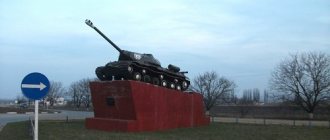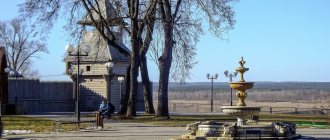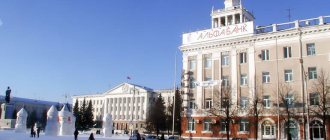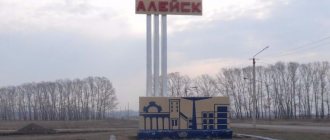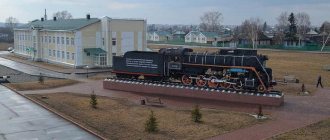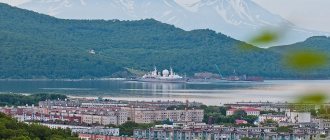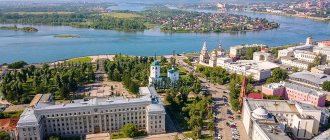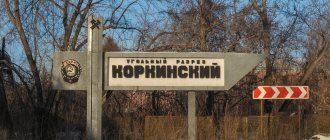The city of Dmitrov is located 65 kilometers from ]Moscow[/anchor], and 50 kilometers from the Moscow Ring Road, north of the capital. It stands on the Yakhroma River and the Canal named after. Moscow. One of the most comfortable cities in Russia. City of Military Glory. Included in the Golden Ring of Russia tourist route. In this article we will get acquainted with the city and its attractions.
Dmitrov history.
Let's start our acquaintance with a little historical background. The city was founded in 1154 by Prince Yuri Dolgoruky in the swampy valley of the Yakhroma River. Named in honor of Vsevolod the Big Nest (baptized Dmitry, son of Yuri Dolgoruky), born that year. The city was conceived as an outpost for the defense of the Vladimir-Suzdal land. Dmitrov was located at the junction of the borders of the Moscow, Tver and Pereslavl principalities. In 1180, during the war between Svyatoslav Vsevolodovich and Vsevolod the Big Nest, Dmitrov was burned. It soon recovered from the ruin and by 1214 it was already a large city with suburbs, and belonged to Yaroslav Vsevolodovich. The city was not spared by the Tatar-Mongols, who burned it about six times.
Dmitrov history.
Dmitrov, during the period of fragmentation of Rus', passed from one prince to another. In 1569, Prince Vladimir Andreevich of Dmitrov was executed, becoming the last appanage prince in Rus', and the city was transferred to the oprichnina. The period from the 16th to the second half of the 17th centuries. Historians associate it with the decline of the city. The situation changed in 1781, when Dmitrov became the center of the county and, among many Russian cities, received a coat of arms. By the end of the 18th century, a new revival in local trade began, which affected the development of Dmitrov. Stone construction was resumed, old wooden churches were rebuilt, and in 1784 the city received a regular development plan.
Historical:
■ Dmitrov Kremlin Museum-Reserve.
■ An ancient settlement with a rampart and a moat.
■ Former Nikolo-Peshnoshsky monastery (1361).
■ Emelyanov’s brick house in the style of classicism (second half of the 17th century).
■ Olgovo estate (XVIII century).
■ Estate of Prince I. F. Golitsyn (Baroque, second half of the 18th century).
■ Nikolskoye-Obolyanovo estate (early 19th century).
■ The master's house in the style of classicism (the village of Podyachevo, early 19th century).
■ Novoselov’s wooden house in the Empire style (1842).
■ The building of the former gymnasium (1876).
■ Olsufiev House (1895).
■ House in the Art Nouveau style by Milyutina (late 19th - early 20th centuries).
■ Houses of the merchant and mayor Voznichikhin, Klyatov, Tolchenov-Tugarinov.
■ Tugarinovskaya almshouse.
Dmitrov history.
In the second half of the 19th century, after the construction of the Nikolaevskaya railway Moscow - St. Petersburg through Klin (1851) and the Yaroslavl railway through Sergiev Posad (1869), Dmitrov, while remaining an administrative center, found itself in a relatively disadvantageous economic position. At the beginning of the 20th century, Dmitrov experienced all the hardships of the revolutionary movement. During the period of Soviet power, the construction of the canal to them became key in the history of the city. Moscow. Construction contributed to population growth and industrial development. In the 1960s–1980s, the city was built up with apartment buildings during the period of rapid development of industrial enterprises and acquired the main features of its modern appearance. For the 850th anniversary of the city (2004), a large-scale campaign was carried out to improve and develop the city.
Dmitrov today.
In 2005, Dmitrov took first place in the All-Russian competition “The most comfortable city in Russia” in the category “Up to 100 thousand inhabitants”. On October 30, 2008, Dmitrov was awarded the honorary title of the Russian Federation “City of Military Glory.” Over the course of more than eight centuries of history, the city has experienced prosperity and decline, wars, revolutions, and despite this, the city has preserved a large number of architectural monuments.
Dmitrov Kremlin.
In the very center of the city is the Dmitrov Kremlin, it is surrounded by an earthen rampart that has survived to this day. The architectural dominant of the Kremlin is the Assumption Cathedral, built between 1509 and 1533. Nearby is an administrative complex (offices, service wings, prison), the buildings of which were built at different times from 1810 to 1830. Much later, a prison Elizabethan church in pseudo-Russian style was added to it. Also within the boundaries of the fortifications there is a gymnasium, a noble assembly and a parochial school. Near the passage of the Nikolsky Gate in 1868, at the expense of the townspeople, in commemoration of the miraculous salvation of Alexander II from the assassination attempt on him in 1866, the chapel of St. Alexander Nevsky in the eclectic “Ton” style.
DMITROV
DMITROV, a city in Russia, in the northern part of the Moscow region, the center of the Dmitrov urban district. Population 68.8 thousand people. (2019). Located on the river. Yakhroma, cargo port on the Moscow Canal. Railroad station. The Moscow-Dubna highway passes through Dmitrov.
Story
Founded in 1154 by the Rostov-Suzdal prince Yuri Vladimirovich Dolgoruky and named in honor of his son Vsevolod Yuryevich Big Nest (baptized Dimitri). From 1157 it was part of the Grand Duchy of Vladimir (after 1212 - in the Principality of Pereyaslavl). In the beginning. 1181 burned by Prince Svyatoslav Vsevolodovich. In 1213, during a strife between the sons of Vsevolod the Big Nest, the Dmitrovites themselves burned the city settlement (which probably appeared in the last quarter of the 12th century) and repelled the attack of the Yuriev prince Vladimir Vsevolodovich, destroying part of his squad.
In the beginning. 1238 Dmitrov was devastated during the Mongol-Tatar invasion. Since 1247, one of the centers of the Galicia-Dmitrov Principality, and after its collapse (between 1280 and 1334) - the Dmitrov Principality (about 1360 it became part of the Moscow Grand Duchy). Repeatedly subjected to Horde raids in the 13th–15th centuries. In 1372 it was captured by the Grand Duke of Tver Mikhail Alexandrovich. The city was taken by one of the Horde detachments during the Tokhtamysh raid of 1382, and was devastated during the Edigei raid of 1408. In 1389, Dmitrov with the adjacent volosts formed the appanage Dmitrov principality, allocated to Prince Peter Dmitrievich. From 1428 it became part of the grand ducal possessions. In the end 1454 – beginning 1455 Dmitrov went to the son of the Grand Duke of Moscow Vasily II Vasilyevich the Dark - Yuri Vasilyevich, after his death (1472) - to the Grand Duke of Moscow Ivan III Vasilyevich, who allocated him to feed Prince Andrei Borisovich of Mikulin, who transferred to the Moscow service. According to the will of Ivan III, the city became the center of the possessions of his son, Yuri Ivanovich (1504–33). In 1566–69 Dmitrov belonged to Prince Vladimir Andreevich. At 15 – 1st half. 16th centuries - a major center for trade in salt, fish, bread, from the 16th century. – production of polished ceramics; Pottery, ironworking, blacksmithing, and jewelry making were developed. The wealth of Dmitrov merchants was noted by S. von Herberstein.
During the Time of Troubles, Dmitrov was briefly captured by the detachment of Ya. P. Sapieha. Changes in trade routes in the 2nd half. 16th century and the ruin of Dmitrov in 1610 led to the economic decline of the city. In the 17th century There were palace settlements in the city (stable settlement, etc.). In 1708–1929, a district town in the Moscow province. In 1900, the Moscow–Savelovo line of the Northern Railways passed through Dmitrov. During World War I, many enterprises in Dmitrov and the district switched to producing military products. In 1918–21, the anarchist theorist P. A. Kropotkin lived in the city, participating in the creation of the local museum. For the construction of the Moscow-Volga canal (from 1947 the Moscow Canal), the Dmitrovsky forced labor camp of the OGPU (from 1934 NKVD; Dmitlag), which was subordinate to the Gulag (1932–38), was created. During the Great Patriotic War, during the Battle of Moscow 1941–42, fierce battles took place near Dmitrov in November 1941 between the Red Army and German troops. In 1929–2018, the regional center of the Moscow region. City of Military Glory (2008). From 2022, a city of regional subordination of the Moscow region, the center of the urban district.
Archeology
Ensemble of the Nikolo-Peshnoshsky Monastery. Photo by A. I. Nagaev
Dmitrov. Assumption Cathedral. Between 1509 and 1533. In the foreground is a monument to Yuri Dolgoruky (2001, sculptor V. Tserkovnikov). Photo by A. I. Nagaev
Dmitrov is an important archaeological site. Its cultural layer up to 2 m thick (divided into three horizons: 11th–13th centuries, 14th–15th centuries and 16th–17th centuries) was identified on the territory of the Kremlin, as well as on the settlement to the northeast of the Kremlin. Detinets (200×120 m) is protected along the perimeter by a rampart (has three breaks, two of which - from the northeast and southwest - on the site of an ancient gate) and a ditch. A wooden wall with towers ran along the shaft; the remains of piles driven into the embankment were discovered. In the horizon of the 11th–13th centuries. (thickness 0.3–0.5 m), including a layer of coal with the remains of wood (possibly traces of fire 1181), fragments of molded and circular dishes, tools, jewelry, etc. were found. Many coins were found on the territory of the Kremlin, which indicates wide trade connections of the city. Remains of wooden dwellings from the 12th–17th centuries have been excavated. with ovens made of clay or square bricks. In the southwestern part of the Kremlin (on the site of the building of the Noble Assembly), a unique cemetery dating from the 12th to 16th centuries was studied. with a total area of at least 400 m2 (out of 177 buried, 100 had a south-southwest orientation of the head, 25 - southwest, 10 - south and only 6 - the usual west; a rich burial of a girl from the 12th-13th centuries was found with silver jewelry and gold sewing a collar, which indicates the high social status of those buried in this cemetery).
Architecture
In accordance with the master plan of 1784, the original radial structure of Dmitrov was largely replaced by a geometric grid of blocks. On the territory of Detinets, the 5-domed, 4-pillar Assumption Cathedral on a high basement has been preserved (between 1509 and 1533; according to some researchers, 1510s), erected on white stone basements with faceted apses and monumental tiled compositions depicting the Crucifixion and St. George Victorious (1st half of the 16th century or 2nd half of the 15th century); central iconostasis – con. 17th century with icons from the 16th–18th centuries. The aisles with pseudo-Gothic elements were built on the site of ancient galleries - the northern one (laid in 1823, architect F. M. Shestakov) and the southern one (project 1841, architect D. F. Borisov). The bell tower of the cathedral (1793–96, architect M. Ya. Agafonov) was built in 1820 according to the design of architect. A.F. Elkitsky. Nearby is the Elizabethan Church (1897–98, architect S.K. Rodionov). Not far from the Kremlin is the Borisoglebsky Monastery (according to legend, founded by Prince Yuri Vladimirovich Dolgoruky, the first documentary evidence of it dates back to 1472; closed in 1926, reopened in 1993) with the single-domed Cathedral of Saints Boris and Gleb (until 1537; restored in the 1900s . under the leadership of architect I. P. Mashkov; Alekseevsky chapel - the burial vault of the Chaplin family of nobles, 1656), the gateway St. Nicholas Church (1672–87; rebuilt in 1834, 1852) and the fence (1685–89). Among other monuments: churches in the Baroque style - Spasskaya (1767–73), Ilyinskaya (1778–83), Troitskaya-Tikhvinskaya (1795–1801); samples of wooden Empire and neo-Empire styles (houses of the Klyatovs, Novoselov, Vadbolsky). Complex of the Podlipichye estate (which became part of the city in the 1930s) - the main house (2nd half of the 18th century, twice rebuilt in the middle - 2nd half of the 19th century, with eclectic decor) and Kazan church (1735–53; chapel, 1778–79, architect I. M. Samarin). In the Zarechye area there is the baroque Vvedenskaya Church (1766; iconostasis, 2nd half of the 18th century; bell tower, 1786, 1832), the estate of A. I. and I. A. Tolchenov (the main building of the merchant estate, 1785), etc.
Centers of science and culture
Branches and representative offices of universities, including MSTU, Moscow State Academy of Instrument Engineering and Informatics, Russian State University for the Humanities, Dubna University. Economics-legal and polytechnic colleges, medical school. Museum-reserve "Dmitrov Kremlin" (1918). Theaters: drama "Big Nest" (1991), children's "Snow White" (1992).
Sport
Sports complex "Dmitrov", stadium "Lokomotiv". Dmitrov is a traditional center of aeronautics; international hot-air balloon competitions are held annually for the Moscow Region Governor's Cup, and Russian championships have been held. The city also hosts stages of the Russian motorcycle racing championship. Women's hockey club "Tornado" (founded in 2003) - 9-time champion of Russia and 6-time silver medalist (from 2004 to 2018); 4-time winner of the European Cup (2010 and 2012–14) and 2nd medalist in 2007.
Farm
Factories: experimental aluminum and combined tape (for the production of canning containers, ventilated facades, slatted ceilings, etc.), milling machines, excavator (trench excavators, road machines, etc.), experimental mechanical (flaw detectors for monitoring components and assemblies of railway rolling stock transport, equipment for the repair of components and assemblies, etc.), "Dmitrov-Kable" (cable and wire products), reinforced concrete bridge structures, flexible packaging (products mainly for the needs of the food industry: bags, foil, films, etc.), woodworking (lumber, window blocks, etc.). Production of lifting equipment for car services (DARZ company), signaling devices to ensure the safety of transported goods (Alfa-Siltek company), building materials (PVC siding, facade panels, etc. - Deke Extrusion company), furniture (Ladya factory ", upholstered furniture), hosiery, hats, gloves ("Dmitrovsky knitwear"), dairy ("Dmitrovsky Dairy Plant"), meat () products, etc.
Neighborhood
Near Dmitrov, in the village. Lugovoy, - ensemble of the Nikolo-Peshnoshsky monastery (founded in 1361; closed in 1920, it housed a psychiatric hospital): cathedral and bell tower (late 15th - 1st third of the 16th centuries, restored in the 1960s); refectory with the Presentation Church (1st half of the 16th century, rebuilt in the classicist style at the turn of the 18th–19th centuries); churches - hospital St. Dmitry of Rostov with the body of cells, 1811–29, and the Preobrazhenskaya gate, end. 17th century; cells, con. 17th – 19th centuries; brick walls and towers, 17th – 1st third of 18th centuries. In the village Hermitage is the Church of the Nativity of the Virgin Mary (1547) and the bell tower (16th century, rebuilt in 1871) of the former Medvedeva Hermitage. Not far from Dmitrov, a number of noble estates have been preserved: Danilovskoye [ensemble with a central-axial layout in the Baroque style: a house (late 1760s - early 1770s, heavily rebuilt in the 2nd half of the 19th century) with outbuildings , St. Nicholas Church, 1768–71]; Olgovo; Nikolskoye-Obolyanovo (main house in the classicist style, St. Nicholas Church, 2nd half of the 18th century, and landscape park, late 18th century). Among other monuments is St. Nicholas Church in the village. Batyushkovo (1666; type of Moscow posad church), churches: Assumption in the village. Shukolovo (1701; bell tower, 1762, rebuilt in the 1st quarter of the 19th century), Nikolskaya in the village. Ozeretskoe (1704–1708; in the Moscow Baroque style), baroque Nativity of the Virgin Mary in the village. Selevkino (not earlier than the early 1770s), classic Pokrova in the village. Andreevskoe (1803; according to the design of the 1790s by architect F. Camporesi), Nikolskaya in the Russian-Byzantine style in the village. Rogachevo (1862–86; refectory – 1850–53; bell tower – 1877). In the village Verbilki – Dmitrov Porcelain Factory.
Monuments to Dmitrov.
Several 19th-century buildings are located southwest of the Kremlin. Among them, the Sukhodayev Hotel (1872) stands out, where the district administration is now located. Behind it, along Sovetskaya Street, is the former Spasskaya Church, rebuilt in Soviet times and now occupied by the services of the Dmitrovsky district administration. There are a large number of monuments in the city. The monument to Yuri Dolgoruky, Boris and Gleb, Cyril and Methodius are the most interesting of them. On the territory of the city there is the Architectural complex of the Boris and Gleb Monastery.
The city of Dmitrov certainly deserves the attention of tourists; all the necessary infrastructure has been created for this. Dmitrov is perfect for a weekend tour. In a couple of days you can explore the main attractions, visit several museums and enjoy the peace and tranquility of the provincial town. We tried to tell you the most interesting things about the beautiful city of Dmitrov, we wish you great travels and positive emotions.
Boris and Gleb Monastery
History has not preserved the exact date of creation of the Boris and Gleb Monastery; its oldest buildings date back to the 15th-16th centuries. The earliest mention of the monastery is indicated in the will of Prince Yuri Vasilyevich in 1472. The Boris and Gleb Monastery was repeatedly attributed to the composition of other monasteries. In 1682 they wanted to assign him to the Zaikonospassky Monastery, but the addition did not take place. From 1724 to 1726 was assigned to the Novgorod Bishops' House. Since 1764, the Boris and Gleb Monastery remains the only monastery in Dmitrov (Pyatnitsky and Nikitsky were abolished). Since 1926, the monastery has been closed and given to the local history museum. Since that time, the monastery has housed: a GULAG department for the construction of the Volga-Moscow canal, a military unit and various other organizations. Restoration of the monastery began in 1993; by 2004 it was completely restored and re-consecrated.
In 2006, a monument to princes Boris and Gleb was erected near the walls of the monastery - the first Russian saints, protectors of the Russian land and heavenly helpers of the Russian princes. Boris and Gleb were the sons of the Kyiv prince Vladimir Svyatoslavich (Vladimir the Red Sun), and were killed by their older brother Svyatopolk the Accursed.
The stone Cathedral of Boris and Gleb is the oldest building on the territory of the monastery and the center of the entire composition. In the 17th century, a three-tier hipped bell tower was added to it.
The Chapel of the Descent of the Holy Spirit was built next to the cathedral in 2004.
The Gateway Church of St. Nicholas was built under Archimandrite Kallistrat in 1685-1687 over the Holy Gates.
Abbot's house from the 19th century.
Monastic poultry house, also known as an aviary for peacocks. In the warm season, peacocks walk around the monastery!
